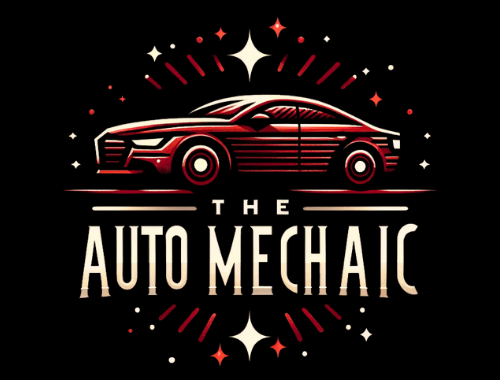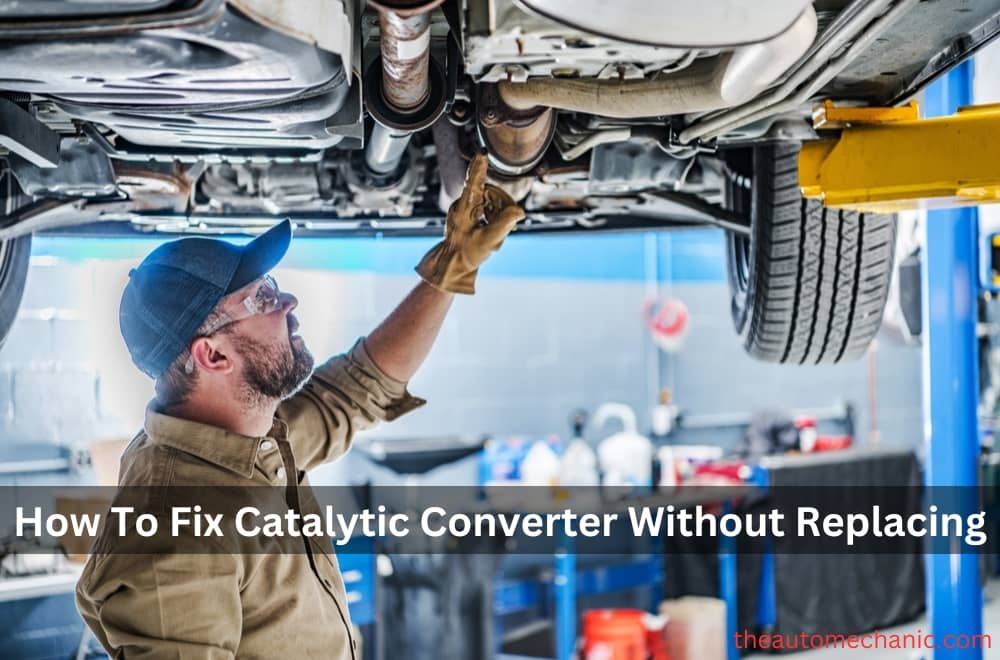You might want to know how to fix the catalytic converter without replacing it. Why not, as it will save you tons of bucks? However, you can do so if you do not notice symptoms like a rattling sound, discoloration, or even an awkward smell.
The catalytic converter can be fixed easily. You can either wash it or use a lacquer thinner. We will discuss all of them in the later part of our article. All the concept of a catalytic converter depends on the question, “What is a catalytic converter?”.
What A Catalytic Converter Is?
Catalytic converters are an important part of your vehicle and expensive, too. The converter’s fundamental purpose is to convert toxic exhaust gases into non-toxic gases like nitrogen, carbon dioxide, and water.
The catalytic converter has a catalyst inside it. A catalyst is an unreactive metal that reacts with those harmful gases and makes them into non-harmful gases. Further, a catalyst remains unchanged at the end of a reaction. Therefore, you do not need to replace it.
A catalyst can be an expensive metal like Rhodium, platinum, palladium, etc. However, it depends on whether the car manufacturer includes precious or less precious metal inside the converter as a catalyst. Expensive car manufacturers like Ferrari put gold inside the catalytic converter to act as a catalyst.
Furthermore, nowadays, it is illegal to drive without a catalytic converter. Therefore, the catalytic converter ensures your vehicle passes the Vehicle Emission Test.
Due to the expensive metal inside, a catalytic converter’s replacement cost is high. You should expect to spend a minimum of 1,000 bucks for one. Therefore, it is always good to know how to fix a catalytic converter without replacing it.
However, how will you know your catalytic converter is facing problems? We will discuss them now.
Problem Diagnostic Process
Faulty parts always show symptoms of faults inside them. The catalytic converter is no exception. Naturally, the converter will show issues over time. There are several reasons for this, such as being dirty or clogged.
You should know the difference between cleaning and replacing your catalytic converter. Below are the symptoms that show you need to replace it.
-
Knocking Sound
You should always remain vigilant about what kind of sound your vehicle is making. Further, a sound might indicate your vehicle’s internal problems. One of the sounds is the catalytic converter rattling.
The rattling sound comes from inside the converter. The catalytic converter has metals inside, which might get broken, causing the sound.
-
Change Of Catalytic Converter Color
A faulty catalytic converter might show a shift in color or appearance. Your vehicle’s catalytic converter will shift its color if it has any internal leaks. Moreover, overheating also changes the color of the converter.
-
Pungent Smell Of Sulfur
The catalytic converter might produce a pungent sulfur smell. However, this does not guarantee its replacement. Further, it might also mean that it needs to be cleaned.
The sulfur smell indicates that the catalytic converter fails to convert harmful gases into less harmful ones. It is similar to that of rotten eggs and is most noticeable from the exhaust system.
A catalytic converter converts hydrogen sulfide into sulfur dioxide. However, it cannot convert with a failing catalytic converter, resulting in that smell.
You might also see black smoke out of your vehicle.
The Possibility Of Cleaning Catalytic Converter
We have listed some symptoms that will show if your catalytic converter needs to be replaced. However, you might not see those symptoms. If so, then you are on your luck. How can you know that your catalytic converter needs cleaning? Further, you should also know how to fix a catalytic converter without replacing it.
-
Degradation In-Vehicle Performance
The catalytic converter is connected to the exhaust pipe. It might become clogged during daily usage, preventing normal exhaust gas flow from the pipe. As your car’s engine fails to release exhaust gas quickly, the vehicle’s performance will decrease dramatically.
-
Poor Gas Economy
A clogged catalytic converter reduces the engine’s efficiency. Your engine will need to produce more power to exit the same amount of gas. Further, the fuel-to-air ratio decreases, which is also a factor in the poor gas economy.
Poor airflow also impacts the vehicle’s combustion reaction in the combustion chamber, which in turn impacts its gas economy. This sign means you need to know how to fix the catalytic converter without replacing it.
-
Slow Acceleration Or Lagging Start
Poor acceleration and lagging start indicate that the catalytic converter is clogged. Clogged catalytic converters halt exhaust gases from exiting the exhaust system, which impacts the vehicle’s acceleration and lag start.
-
Look For Engine Light
Engine lights are often ignored by vehicle owners. They are scared of engine lights as they feel they indicate huge vehicle repair costs. However, you should be careful with engine lights and deal with them seriously. A minor issue might become a major one with time. Further, an engine light is the initial indication that your catalytic converter needs servicing.
You can use a scanner to diagnose your engine problem. You can also use the OBD2 scanner to find the problem. This tool displays the error code for the specific problem of your vehicle.
These devices are very cheap to purchase, around $50. They are the perfect way to determine what kinds of problems your vehicle is suffering from.
How To Fix Catalytic Converter Without Replacing
You can easily fix your vehicle’s catalytic converter without replacing it or having a hassle. Below, we have provided some ways to fix the converter without spending a lot of money.
However, you can only know how to fix a catalytic converter without replacing it if your converter doesn’t rattle, show discoloration warps, or emits a bleachy sulfur aroma.
Note that it might not be possible to fix the converter. However, the steps for fixing without the replacement process are given below.
-
Make Use Of Fuel Additives
You should use fuel additives once in a while to increase the performance of your vehicle’s engine. Further, the fuel additive also enhances the catalytic converter by cleaning it. This becomes essential for people who use gasoline instead of premium fuel.
However, you can also use high-octane fuel to enhance your vehicle’s performance. Cheap gasoline might also be a reason for the decrease in vehicle performance.
Furthermore, you can use lacquer thinner. Pour a full gallon of lacquer thinner into a half-filled gas tank. Then, take your vehicle for a long drive at high speeds for about 150 miles.
Moreover, you can also drive the vehicle at around 2500 rpm for an hour or so. This will get rid of all the dirt inside the catalytic converter, and the converter will be cleaned at the end of the action. It is one of the efficient ways to know how to fix a catalytic converter without replacing it.
-
Clean Your Catalytic Converter By Washing
Your catalytic converter can also be washed. However, you need to disassemble the catalytic converter first. The disassembling process might sound scary, but you can easily take it off with an amateur experience.
Further, you need to disassemble the converter from the car and pressure wash it. This will clean all the junk inside and outside the converter, including its front and back sides.
You might desire to clean the converter more deeply. To do that, drown it in a detergent solution. Make sure you are using a very strong grease-cleaning detergent. Otherwise, the converter will not be cleaned properly.
After cleaning, dry the converter and reassemble it in your vehicle.
-
Make a Hard Driving
Hard-driving is a remarkable method of fixing catalytic converters without replacing them. Further, it also solves most of the basic problems of your vehicle. However, you should have a clear concept of how a catalytic converter works to have an idea about this mechanism.
Catalytic converters need an optimum temperature to function properly. Pushing the vehicle hard sometimes makes this possible.
The efficient temperature for a catalytic converter to work is around 1,800 degrees. However, most drivers drive their vehicles slowly and do not push the limit, so the converter fails to reach the optimum temperature. Either they drive a short distance or pick up their children from school.
Further, this kind of driving harms the converter and kills it faster than expected. Therefore, we recommend pushing the vehicle hard sometimes. Moreover, try to run your vehicle at higher speeds on high roads.
The action heats the catalytic converter fast and burns all the clogged substances blocking the converter. It also cleans the intake sensors, oxygen sensors, and the head of the cylinder. However, you should ensure you are driving fast on a safe road.
Fix The Reasons For Damage
You should fix why the catalytic converter failed in your vehicle. You should know that a catalytic converter is made to last the lifespan of your vehicle, which is around 100,000 miles. Therefore, you can think that failure is uncommon. There are some reasons why your catalytic converter failed unexpectedly.
Further, you should fix those problems to prevent them from damaging the converter again. This will prevent the converter from dying fast and save you tons of bucks. Below, we have given the cause of the converter failure.
- Clogged Converter due to too much oil.
- There is too much heat generation from inside of the converter.
Now you know how to fix a catalytic converter without replacing it. Further, you also know the causes of such failures. So, should you fix or replace your catalytic converter?
Conclusion
The replacement cost of a catalytic converter is huge. This is due to the expensive metal inside the converter, which raises the price. Most catalytic converters cost around $1000 to $2000. However, the price might vary depending on the vehicle and brand.
Therefore, we recommend you look for ways to fix the catalytic converter without replacing it. This is the safest bet to save your money. However, if the problem persists without replacement steps, you have to replace the converter.
By now, you should know some of the ways to identify whether your vehicle’s catalytic converter needs replacement. However, you are on your luck if no replacement is needed, and things can be fixed through washing or cleaning.

Bruce William is a professional content writer and vehicle engineer with extensive car maintenance and repair knowledge. His expertise spans all vehicle parts, offering practical solutions for various automotive issues. Bruce provides valuable insights through his website articles to help readers maintain their cars for optimal performance and longevity.

